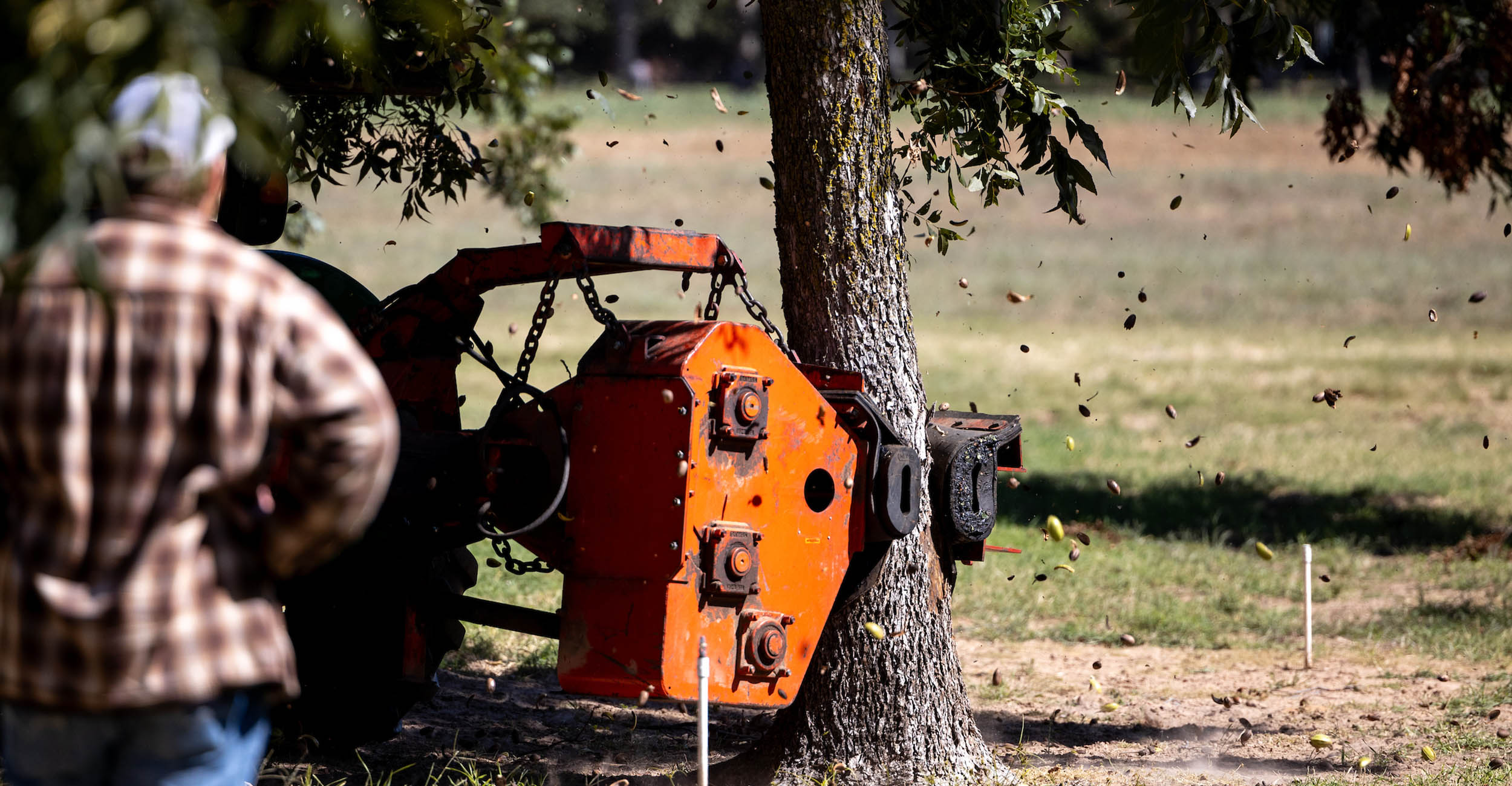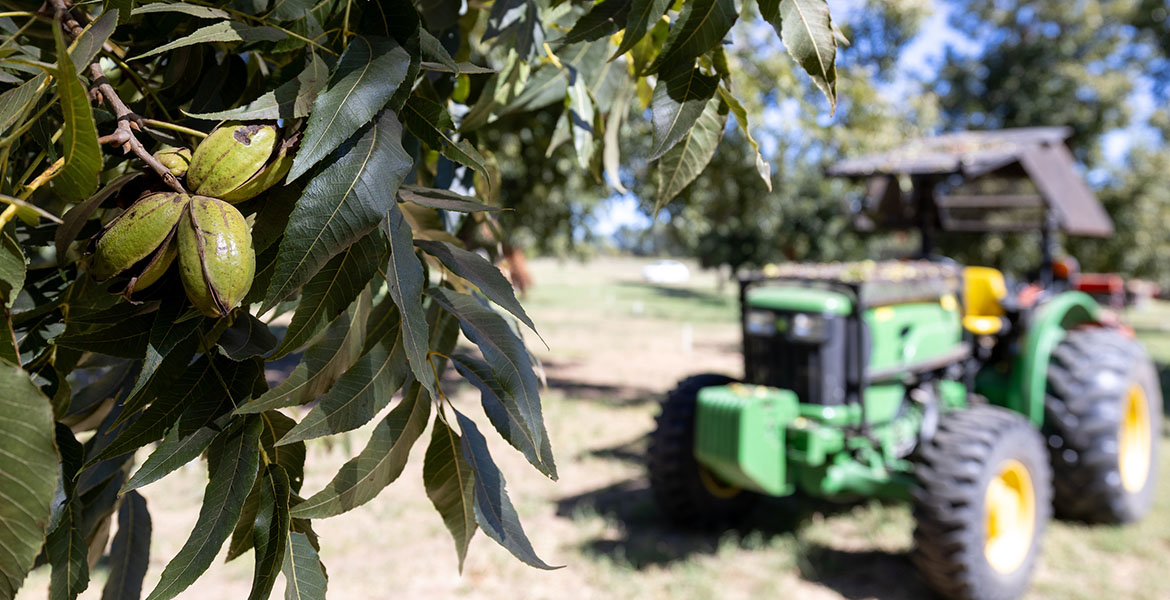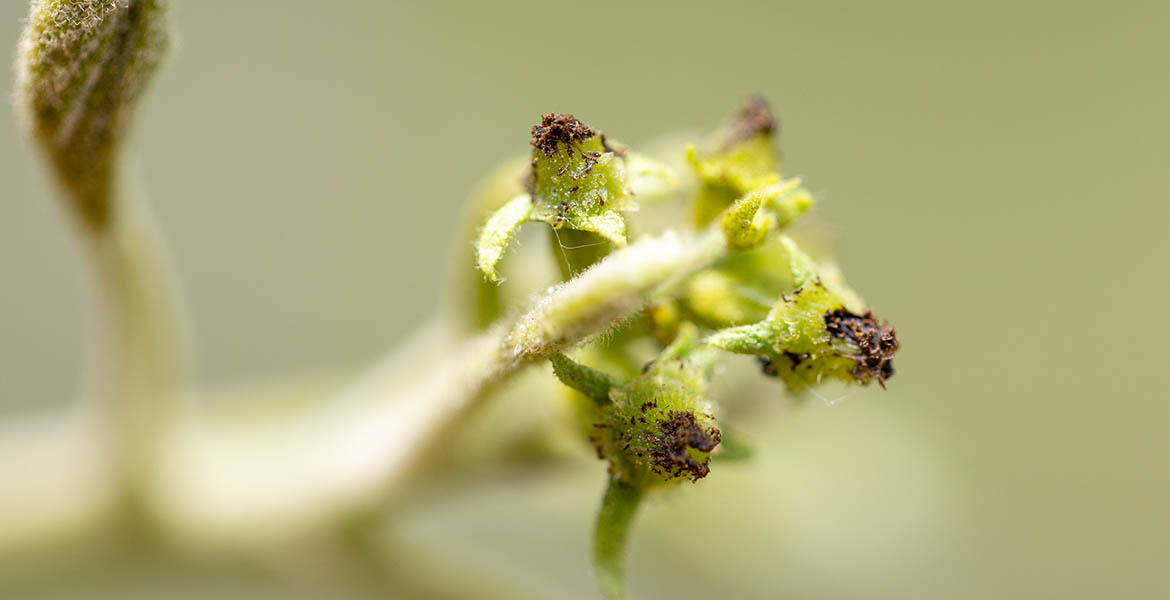
Pecans are the pick of the season
Wednesday, October 9, 2024
Media Contact: Gail Ellis | Editorial Communications Coordinator | 405-744-9152 | gail.ellis@okstate.edu
The state’s wholesale pecan industry generates $23 million a year, and with the 2024 harvest on the horizon, Oklahoma pecan producers are preparing for a busy season.
Becky Carroll, Oklahoma State University Extension fruit and nut specialist, said statewide retail sales, value-added products and other businesses like equipment manufacturers, pesticide and fertilizer distributors, and applicator services also contribute to the state’s economy.
The exact number of commercial growers across the state is difficult to pinpoint. The 2020 U.S. Census of Agriculture reports 2,044 farms in pecan production on 113,719 acres. Many acres of pecan trees remain untouched or are managed at different levels yearly.
“A lot of growers use pecans as a cash crop, and if they’re not worth picking up, then they don’t get out their equipment and harvest that year,” said Jon Vantrease, president of the Oklahoma Pecan Growers Association.
Oklahoma is one of the top two states in the nation for native pecan production due to abundant sunlight, rich soil and adequate water found primarily in the eastern part of the state. Many pecan groves sit along creek beds or river valleys and produce an average of 400 to 800 pounds per acre of nuts annually.
“The trees require about 54 inches of water a year, so that’s why we don’t see native trees in many western counties,” Carroll said. “Our number of growing days is sufficient to ripen pecans as well.”
Buy, sell and shell
Some pecan operations offer additional services to meet the needs of producers and customers. Jarod Miller and his brother, Justin Miller, own and operate Miller Pecan Co. near Afton in northeast Oklahoma. Their father custom-harvested pecans, and the brothers began growing them in the 1990s. They harvest 850 acres of pecan trees and operate the largest processing plant in Oklahoma.
“Some years, we crack the state’s entire crop, but our retail sales are also growing,” Justin Miller said. “That second week of October is when people start thinking about baking and using a lot of pecans.”
Harvest for improved pecan varieties, which grow from grafted cuttings, begins in mid-October. Native pecans — those grown in the wild — are harvested in November.
The Millers buy, sell and shell pecans.
“We’re expecting a good crop this year,” Justin Miller said. “All of our pecans are in a river bottom. We had adequate rainfall in July and early August, and the nuts sized and filled out pretty well.”

Producer Chad Selman, who grows pecans from Bartlesville to Verdigris, is also an entrepreneur in the pecan industry. After college, he began leasing orchards and equipment from his father, a longtime pecan grower. Today, Selman owns a portion of Southern Roots Nut Co., which operates a shelling plant in New Mexico, and he brokers pecans throughout the central and eastern U.S.
“We produce good crops year in and year out as long as we don’t have early freezes as far as native pecans go,” Selman said. “Pecans do well in soils that hold a lot of water, so we’re able to take on some of these droughts a little bit better than some of the other crops here in Oklahoma. Our pecans are more resistant to drought.”
Growing an industry through research and Extension
Carroll said pecans were first recognized by Native Americans as a reliable energy source, sustaining tribes during the fall and winter. Spanish explorers were introduced to pecans as they traveled through Oklahoma in the 1500s. The U.S. began planting pecan seeds in the 1700s, and commercial production began in the late 1800s.
“In the 1940s and 1950s, pecan equipment sparked a large increase in pecan farms and production,” Carroll said.
OSU Extension established the Oklahoma Pecan Field Station in Lincoln County in 1946 to research the best native pecans for Oklahoma’s diverse regions. After the station closed in 1990, pecan trees were planted at the Cimarron Valley Research Station near Perkins in Payne County. OSU Extension pecan research continues at the location and other orchards across the state.

Carroll said OSU researchers have left their mark on the pecan industry by advancing production methods worldwide. Trials in crop load management, nutrition recommendations, pest management and a Mesonet weather model for preventing disease were developed by OSU Extension specialists as well as faculty in the OSU Ferguson College of Agriculture.
“We’ve had great support from the OSU entomology department, pathologists and Extension and learned so much over the years,” said Bill Ihle of Pecan and Agricultural Equipment, located in Bristow. “Back in the 1960s, the general thought was if something moved in your orchard, you sprayed it. Now we know you only spray when you need to. Biological insecticides help our programs, and we’ve learned how beneficial insects can help control the aphid.”
Ihle’s father, who is still involved in the industry today at 102 years old, established a pecan processing company in 1955, supplying pecans to customers like Braum’s Ice Cream and Bama Companies. Ihle followed in his father’s footsteps and manages Pecan and Ag Equipment, supplying producers with shakers, harvesters, sprayers and other pecan production needs. As a dealer for Savage Equipment Company products manufactured in Madill, Oklahoma, Ihle’s pecan venture specializes in assisting new and experienced pecan growers with their chemical and pesticide needs.
“The pecan industry is unique in that every year we’re managing the same trees,” he said. “We’re not tilling the soil or planting row crops. You get to know your trees because you see them year after year.”

In addition to Pecan and Ag Equipment, the family owns a native pecan orchard along the Deep Fork River that it purchased in the early 1960s. Ihle, his father and his two sons represent three generations in the Oklahoma pecan industry. After decades of experience in the business, Ihle said he’s learned marketing is just as important as a quality product.
“The best money in the industry today is taking the pecans right from your orchard to the consumer,” he said. “The consumer mindset is if you buy pecans straight from the orchard, it’s a healthier product. Fresh pecans have more flavor, and the kernel is brighter in color. Think ahead to create that connection from the orchard to the consumer and maximize your profit.”
Grow an orchard with OSU Extension
Since 1997, OSU Extension has offered a monthly Oklahoma Pecan Management Class with in-person instruction at the Cimarron Valley Research Station.
“The course is unique in that we study pecan trees from dormancy to harvest and discuss what needs to be done each month,” Carroll said. “Experts provide timely classroom lectures and hands-on opportunities out in the field.”
Registration for the pecan management class begins in November and costs $250. Other pecan educational programming includes:
- Free spring pest workshop, Feb. 20, in Shawnee. Producers learn about insects, disease, weeds and other pest management strategies. Private pesticide applicator continuing education units are provided.
- Mini pecan class during the Oklahoma Pecan Growers Association annual meeting with basic information on establishing an orchard, pecan cultivar selection, disease and insects.
- Summer field day during the Oklahoma Pecan Growers Association meeting at a local orchard.
- Free fall field day at a grove or orchard to highlight its operations and discuss timely management practices for growers.
- Expertise from Carroll through state grafting workshops, speaking events, fact sheets and other requested content.
Although pecans are popular for baking and holiday meals, they are a healthy option any time of the year. A high-energy, low-carb and heart-healthy snack, pecans are a nutritious addition to yogurt, oatmeal or salads. Due to their high fat content, pecans are best when stored in the freezer.
Learn more about growing native pecans and the Oklahoma pecan industry by contacting Carroll at becky.carroll@okstate.edu.
